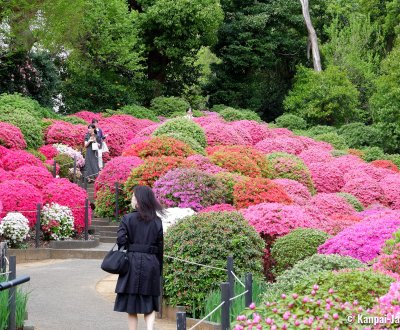Bunkyo Tsutsuji Matsuri
Nezu-jinja’s Azalea Festival
Bunkyo Tsutsuji Matsuri is the azalea festival held at Nezu-jinja shrine, in northern Tokyo’s Bunkyo Ward in Japan. April visitors can admire the gradual flowering of 3,000 azalea bushes growing on a hill next to the Shinto pavilions. Traditional and cultural events are also staged during this colorful seasonal festival.
The spring flowering season opens with the sakura blossoms and continues with other flowers that are equally beautiful, such as the Japanese azalea (アザレア azarea or ツツジ tsutsuji), a type of rhododendron that blooms in April in Tokyo.
In the north of the capital, Nezu-jinja shrine is home to one of the 5 great seasonal festivals of Bunkyo ward, called Bunkyo Tsutsuji Matsuri. It takes place throughout April and focuses on a 3,000 azalea shrub garden located in the sacred grounds and that opens only on this occasion. The hundred various rhododendron species bloom gradually, usually peaking around mid-April (provided the weather conditions of the preceding weeks were favorable).
While the vermilion pavilions of its preserved traditional architecture are already remarkable, Nezu-jinja is further beautified by the bright colors of the azalea blooming, that bring dazzling immaculate white hues and nuances of pink, purple and red. Some shrubs even display yellow or orange flowers. The flowery and colored scenery offers a wonderful contrast with the tenderness of the trees’ young green leaves.

Flowery hill with a view on Shinto pavilions
The first shrubbery were planted on the mound more than 350 years ago for Tokugawa Tsunashige (1644 – 1678), the son of shogun Tokugawa Iemitsu, and lord of the feudal domain of Kofu, during the Edo period (1603 – 1868). The azalea garden was first named Tsutsujigaoka, and from its height, one can still admire the view on:
- The shrine’s Romon gate; and,
- The short Senbon-Torii tunnel.
Note that these elevated views are only available during the matsuri and the garden’s alleys are closed to the public otherwise.

In addition to the blooming, several events are held over the weekends and holidays happening during the festival, such as:
- A parade of mikoshi floats;
- A demonstration of matoi pole handling; and,
- An antique market.
A special limited edition goshuin is also available for purchase (¥1,000 / ~US$6.99) during the festival.
Bunkyo Tsutsuji Matsuri is a very popular seasonal event for the Japanese, especially as it shortly overlaps the Golden Week national holidays starting at the end of April. The festival attracts is fair share of crowd and we recommend preferring a week day to discover Nezu-jinja’s azalea garden. For more rhododendron, Shiofune Kannon-ji temple in the Westernmost side of Tokyo prefecture also has its festival celebrating a valley garden of about 17,000 azalea shrubberies and their blooming flowers.

